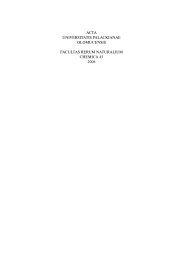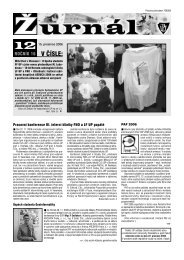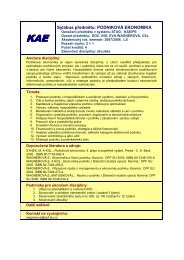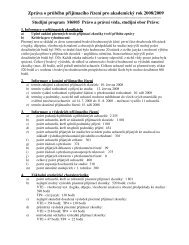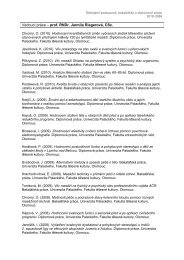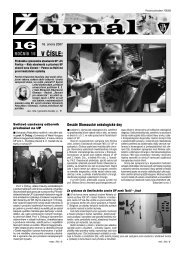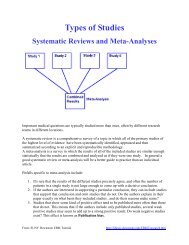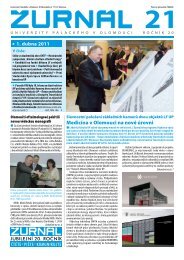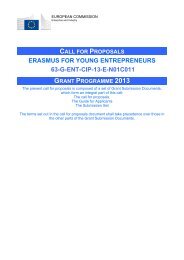48 Acta Univ. Palacki. Olomuc., Gymn. 2004, vol. 34, no. 2Goal-directed manipulated independent variable1. Position during experiment (standing, supine, sitting).2. Respiratory frequency (rhythmised respiratory frequency12 cycles/min. at intervals T2, T3, spontaneousrespiratory frequency at intervals T4, T5, T7,T9).3. Special respiratory techniques used in yoga (full yogabreath), breathing alternatively through the right andleft nostrils (anuloma – viloma), rapid diaphragmrespiration (kapalabhaty).4. Age (20–25 years), health condition (healthy individuals).5. Examination conditions (without medications, 24hours prior to the start there was an absence ofelevated physical load, the consumption of alcohol,and smoking. The examination was always carriedout before noon under laboratory conditions).Observed dependent variables – experimental effects1. The effect of orthostasis and horizontal position witha rhythmised respiratory frequency of 12 cycles/min.on changes of observed functional parameters SAHRV.2. The effect of rhythmised and spontaneous respiratoryfrequency on changes of observed functionalparameters SAHRV while lying.3. The effect of a position change from lying to sitting duringspontaneous respiration on the functional changesof observed functional parameters of SAHRV.4. The effect of the voluntary regulation of the breathingpattern while sitting at the intervals T6, T8,and T10 on changes in the observed functionalparameters of SAHRV in comparison to intervalswith spontaneous respiration (intervals T5, T7, T9)while sitting.Interpretation of supposed changes of observed functionalparametersA rhythmised respiratory frequency of 12 cycles/min.We will regard to be a demonstration of parasympatheticactivity the following:• The enhancement of the absolute and relative spectralpower of frequency component HF, the simultaneousincrease of the parameter CCV HF in a lyingposition, the extension of R-R interval length and thedominant HF frequency which is bound to respirationfrequency in the following relation: Respirationfrequency (min -1 ) x 0.0167 = dominant frequency HF(mHz).We will regard the following to be a demonstration of enhancedsympathetic activity:• A decline in total spectral power as well as in therelative and absolute spectral power of the frequencycomponent HF, a reduction in the parameter CCVHF, an enhancement of relative spectral power in thezones VLF and LF, the enhancement of CCV VLFand LF, and a decrease in the R-R interval length.We will regard to be a demonstration of the enhancedfunctional activity of the autonomous nervous system:• The enhancement of total spectral power in ms 2 .Respiratory bound frequency, regarded as vagus activity,will be assessed as:• The dominant frequency respiration at a frequencyof 12 cycles/min. in the HF zone in the fi eld of0.2 Hz.Voluntary regulation of the respiratory patternWe will regard to be a demonstration of enhanced vagusactivity, respectively respiratory bound vagus activity:When, while using the technique of bradypnoe, the averagerespiratory frequency is less than 9 cycles/min. (interval T6– full yoga breath, interval T8 – anuloma, viloma).• The enhancement of total spectral power; the enhancementof the relative power of the frequencycomponent LF and the dominant frequency in theLF zone that is bound to respiration frequency; a simultaneousdecrease in the absolute as well as in relativepower in the zone of frequency component HF(effect of the shift of a respiratory bound frequencyinto the zone of the LF frequency component).During intensified shallow diaphragm breathing (kapalabhatytechnique).• A total reduction in spectral power, a marked reductionin the absolute spectral power of the HFfrequency component, and a simultaneous extensionof R-R intervals.RESULTS1. Frequency changes in HF and LF components in observedrespiratory techniques depending on respirationfrequency (TABLES 1–5; Fig. 1 and 2).During examination of heart rate variability ata rhythmised respiratory frequency of 12 cycles/min.at interval T2 (standing) and at interval T3 (lying afterorthostasis) the frequency bound to the respiratoryfrequency in the region of 0.2 Hz in the fi eld of highfrequency component HF with low values of standarddeviation was dominant (TABLE 1, Fig. 1). This frequencyrange for the given condition we regard to be thefrequency zone of total parasympathetic activity. At T4(lying with spontaneous respiration) the average value ofrespiration in the examined individuals was 11.8 cycles/min. The standard deviation value thus shows considerablevariability in the value of average respiratory frequency.Under these conditions when individual shifts offrequency bound to respiration occur, the average value ofthe observed respiratory frequency does not relate strictlyto the average value of minute respiration calculatedfrom the relationship between respiratory frequency
Acta Univ. Palacki. Olomuc., Gymn. 2004, vol. 34, no. 2 49TABLE 1Changes in selected functional parameters of SAHRV at intervals with rhythmised and spontaneous respiratoryfrequencyT2 standing, rhytm.resp. T3 lying, rhytm. resp. T4 lying, spont. resp. Stat. sig.Parameter x – S x – S x – S T3 : T4Spect. pow. VLF 1566.6 1275.85 540.42 383.57 969.42 1101.77Spect. pow. LF 1116.5 758.81 740.87 698.45 1788.66 1685.13 *Spect. pow. HF 1261.4 1017.36 5974.87 5492.28 4705.76 4976.35Rel. sp. pow VLF 39.54 15.74 9.26 6.46 15.11 11.27 *Rel. sp. pow LF 29.75 11.67 11.89 9.05 24.08 19.18 *Rel. sp. pow HF 30.71 14.58 78.84 11.37 60.81 19.57 **Freq. VLF 20.15 5.47 20.89 3.85 24.17 8.32Freq. LF 78.72 15.42 104.61 29.76 111.46 28.73Freq. HF 206.37 7.62 204.35 12.35 241.15 73.7Rat. LF/HF 1.33 0.96 0.18 0.18 0.38 0.36 **R-R interval 0.75 0.12 1.09 0.16 1.1 0.17CCV LF 4.29 1.47 2.27 0.83 3.42 1.81CCV HF 4.47 2.02 6.59 2.68 5.73 2.96 *Total spect. pow. 3944.1 2596.02 7256.17 5886.94 7463.5 6592.97Resp. freq./min. 12 0.45 12 0.7 11.8 3.8Counted Fr. resp. 12.34 0.46 12.21 0.74 14.49 4.41Fig. 1Changes in dominant frequencies at frequency component zones of VLF, LF and HF during lying with rhythmisedrespiratory frequency of 12 cycles/min. during standing (interval T2), during lying (interval T3), during spontaneousrespiratory frequency (interval T4)mHz300250200150100500T2 T3 T4Freq.VLFVLFFrekq. Freq. LFFrekv. Freq. HFand the position of respiratory bound frequency (TABLE1). During spontaneous respiration, the ratio betweenrespiratory volume and respiratory frequency and theratio between the duration of inspiration to expiration fluctuates.These individual oscillations of respiratory rhythmduring the measured interval, coupled with spontaneousrespiration, create frequency and amplitude modulationin the component bound to respiration regarded asvagus activity. A high variability of respiratory boundfrequency values is the result of these frequency shiftsduring spontaneous respiratory frequency. In thegraphic and numerical protocol of SAHRV results andin young healthy individuals it is possible to preciselyanalyse the position of this component.
- Page 1 and 2: ACTAUNIVERSITATIS PALACKIANAE OLOMU
- Page 3 and 4: ACTAUNIVERSITATIS PALACKIANAE OLOMU
- Page 5: Acta Univ. Palacki. Olomuc., Gymn.
- Page 8 and 9: 8 Acta Univ. Palacki. Olomuc., Gymn
- Page 10 and 11: 10 Acta Univ. Palacki. Olomuc., Gym
- Page 12 and 13: 12 Acta Univ. Palacki. Olomuc., Gym
- Page 14: 14 Acta Univ. Palacki. Olomuc., Gym
- Page 17: Acta Univ. Palacki. Olomuc., Gymn.
- Page 20 and 21: 20 Acta Univ. Palacki. Olomuc., Gym
- Page 22: 22 Acta Univ. Palacki. Olomuc., Gym
- Page 26 and 27: 26 Acta Univ. Palacki. Olomuc., Gym
- Page 28 and 29: 28 Acta Univ. Palacki. Olomuc., Gym
- Page 32 and 33: 32 Acta Univ. Palacki. Olomuc., Gym
- Page 34 and 35: 34 Acta Univ. Palacki. Olomuc., Gym
- Page 36 and 37: 36 Acta Univ. Palacki. Olomuc., Gym
- Page 38 and 39: 38 Acta Univ. Palacki. Olomuc., Gym
- Page 40 and 41: 40 Acta Univ. Palacki. Olomuc., Gym
- Page 43 and 44: Acta Univ. Palacki. Olomuc., Gymn.
- Page 45 and 46: Acta Univ. Palacki. Olomuc., Gymn.
- Page 47: Acta Univ. Palacki. Olomuc., Gymn.
- Page 51 and 52: Acta Univ. Palacki. Olomuc., Gymn.
- Page 53 and 54: Acta Univ. Palacki. Olomuc., Gymn.
- Page 55 and 56: Acta Univ. Palacki. Olomuc., Gymn.
- Page 57 and 58: Acta Univ. Palacki. Olomuc., Gymn.
- Page 59: Acta Univ. Palacki. Olomuc., Gymn.
- Page 62 and 63: 62 Acta Univ. Palacki. Olomuc., Gym
- Page 64 and 65: 64 Acta Univ. Palacki. Olomuc., Gym
- Page 66 and 67: 66 Acta Univ. Palacki. Olomuc., Gym
- Page 68 and 69: 68 Acta Univ. Palacki. Olomuc., Gym
- Page 70 and 71: 70 Acta Univ. Palacki. Olomuc., Gym
- Page 72 and 73: 72 Acta Univ. Palacki. Olomuc., Gym
- Page 74 and 75: 74 Acta Univ. Palacki. Olomuc., Gym
- Page 76 and 77: 76 Acta Univ. Palacki. Olomuc., Gym
- Page 78 and 79: ACTAUNIVERSITATIS PALACKIANAE OLOMU



